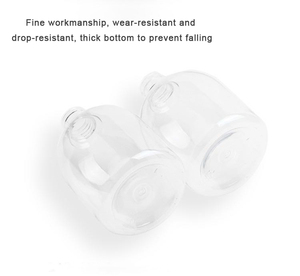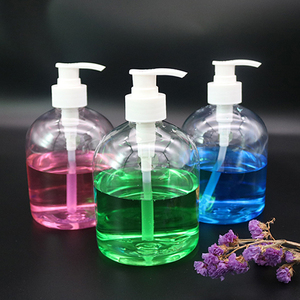(27477 products available)
















































































































































































































 Ready to Ship
Ready to Ship















Hand soap dispenser pumps are devices used to dispense liquid soap from a container. They are commonly found in bathrooms and kitchen sinks. The hand soap dispenser pump is designed to release a small amount of soap when pressed down. This mechanism makes it easy to use soap for washing hands. Hand soap dispenser pumps come in different sizes and designs. Below are some common types:
Standard Dispenser Pump
This is the most common type of hand soap dispenser. It is controlled by the user pressing down on the pump. The standard dispenser is popular in home settings. It is also found in offices and public restrooms. The design is simple and it is easy to refill. This hand soap dispenser pump is suitable for low-traffic areas. It is not designed for heavy usage.
Commercial Dispenser Pump
The commercial hand soap dispenser is meant for high-traffic areas. It is commonly found in schools, hospitals, and malls. The pump is designed to release soap in large quantities. It has a more durable construction. The dispenser is often compatible with bulk soap refills. This makes it more cost-effective than other types.
Automatic Dispenser Pump
The automatic hand soap dispenser is modern and sophisticated. It is designed to release soap without touching the pump. Users place their hands underneath the nozzle. The built-in sensor detects the hands and it triggers the pump. The automatic dispenser is more hygienic. It is suitable for places where hand hygiene is very important. This includes kitchens and hospitals.
Foam Soap Dispenser Pump
This dispenser is specifically made for foam soap. When users press the pump, it releases soap in a foamy form. The foam hand soap dispenser lasts longer than liquid soap dispensers. This is because the soap is already aerated. The pump is very popular in public restrooms.
Decorative Dispenser Pump
These hand soap dispensers are made for home use. They are designed to be eye-catching and stylish. The pump comes in different materials like glass, ceramic, or stainless steel. They are often more expensive than standard dispensers. The decorative dispensers are not suitable for high-traffic areas. They are designed to enhance aesthetics rather than functionality.
Every product has its features and functions, and the same applies to hand soap dispenser pumps. Below are some common features and their functions.
Material
Hand soap dispenser pumps are made from different materials. These materials can be either plastic or stainless steel. Dispenser pumps made from stainless steel are long-lasting and have an elegant look. On the other hand, plastic dispensers are lightweight and available in different colors.
Capacity
This refers to the amount of soap the dispenser can hold. Some dispensers can hold 350ml of soap, while others can hold more than 350ml. Dispensers that have a large capacity require less frequent refilling. As a result, they are suitable for commercial places like restaurants and hospitals.
Dispensing Mechanism
There are various types of dispensing mechanisms. For example, push soap dispenser pumps release soap when one pushes the pump. On the other hand, automatic soap dispenser pumps use sensors to release soap. They provide a more hygienic alternative because users don't have to touch them.
Design
Hand soap dispenser pumps come in different designs. Each design offers different aesthetic and functional benefits. Some designs include; touchless, modern, and minimalist designs. Touchless designs are mostly preferred because they are more hygienic.
Refillable
Most soap dispensers are refillable. They are designed to be filled when the soap is finished. Hand soap dispenser pumps are more economical and environmentally friendly than traditional dispensers that are not refillable.
Compatible with various soaps
Hand soap dispenser pumps are compatible with different types of liquid soaps. For example, hand wash, body wash, and dishwashing liquid. However, it is important to note that some dispensers are specifically designed for handwashing liquid.
There are different scenarios where soap dispensers can be used. These are as follows:
Home
Hand soap dispenser pumps are commonly used at home. They are easy to refill and provide the right amount of soap. The design also adds an elegant look to the bathroom or kitchen.
Schools
Dispensers are used in schools. They help to reduce soap waste. Hand washing is promoted in classrooms and restrooms.
Healthcare Centers
Dispensers are used in hospitals and clinics. They dispense antibacterial soap. They help to prevent the spread of germs in medical facilities and promote proper hand hygiene.
Offices
Soap dispensers are put in restrooms and pantries. They give hand sanitizer and soap. Pump dispensers are more hygienic than touching one.
Public Places
Dispensers are put in public places like libraries, parks, and malls. They are easy to use and refill. They help to reduce the spread of germs in high-traffic areas. They also promote hand hygiene.
Restaurants
Dispensers are used in kitchens and restrooms. They give antibacterial soap and hand sanitizer. The food industry requires hand hygiene to prevent food contamination.
Gyms and Fitness Centers
Hand soap dispensers are used in locker rooms and showers. They give antibacterial soap. This prevents the spread of germs in areas where people sweat and share equipment.
Hotels and Resorts
These dispensers are put in guest rooms, lobbies, and restrooms. They are refilled by staff and provide soap for hand washing. They add a touch of elegance to the bathroom.
Childcare Centers
In daycare centers, soap dispensers are put in classrooms and bathrooms. They give soap that is safe for children. The dispensers promote hand washing to stop the spread of germs among kids.
Industrial Settings
Hand pump dispensers are used in factories and workshops. They give heavy-duty soap that cleans grease and dirt. The dispensers are durable and easy to use in industrial settings.
Choosing the right soap dispenser for wholesale requires considering several factors. Here are some of the factors business owners should consider when buying hand soap dispenser pumps in bulk:
Material and Durability
Soap dispensers are usually made of different materials. Some common materials used are stainless steel and plastic. Stainless steel is durable and elegant. It is also easy to clean and maintain. Soap dispensers made of plastic are lightweight and come in different colors and designs. They are also suitable for various décors. When choosing hand soap dispenser pumps, consider the material used to make them. Choose models that can withstand frequent use and are suitable for the intended market dispensers for home use and those for commercial spaces are made of different materials.
Dispensing Mechanism
Another important factor to consider is the dispensing mechanism. This is because it directly affects the user experience. Some common types of dispensing mechanisms are push-button, manual pumps, and sensor-activated. The push-button and manual pumps are simple and suitable for low-traffic areas. However, they require users to make physical contact with the dispenser. The sensor-activated mechanism provides a touchless option. It uses an infrared sensor to detect hand movements and activate the dispenser. This option is hygienic and suitable for high-traffic areas.
Capacity and Size
Pump soap dispensers are available in different sizes and capacities. The size of the dispenser pump affects its frequency of refills. When buying hand soap dispensers, consider the size and capacity to ensure they meet the needs of the target market. For instance, a large capacity dispenser is suitable for commercial spaces. This option reduces the frequency of refilling. Smaller dispensers are more appropriate for home use. They fit on countertops without taking up much space.
Compatibility with Soap
Dispensers are not universally compatible with all types of soap. Some dispensers work well with foaming soap, while others are suitable for liquid soap. It is important to choose a dispenser that is compatible with the type of soap intended for it. This ensures smooth and consistent dispensing.
Aesthetic and Design
Dispensers come in different designs, colors, and finishes. All these variations influence the pump's function and attractiveness. The aesthetics and design of the soap dispenser pump are important considerations for business owners looking for models that will complement the décor of their customers' spaces. Those pumps are suitable for different settings. For instance, luxurious glass or stainless steel dispensers are suitable for modern bathrooms. Dispensers made of natural materials like bamboo are suitable for a more rustic look.
Q1: What are the trends in soap dispenser pumps?
A1: One of the trends in pump dispensers is the minimalistic design. This trend is all about clean lines and simple shapes. This design can blend into different environments. Another trend is sustainable materials. People care about the environment. So, manufacturers are using recycled or renewable materials to make soap dispensers. These pumps are also getting smart. Some pumps have sensors. These are hands-free dispensers. They're hygienic and convenient, especially in public places.
Q2: Are there soap dispensers without pumps?
A2: Yes, there are. These dispensers have a push-down or lift-and-tilt mechanism. They use this mechanism to dispense soap. They don't have a pump. Examples of such dispensers are commercial bathroom dispensers.
Q3: Are pump soap dispensers better than bar soap dispensers?
A3: Pump soap dispensers are more hygienic than bar soap dispensers. This is because the pump only releases a small amount of soap. The soap stays inside the dispenser until it's time to use it. Hand pumps are more convenient, too. They offer a single-hand operation. Bar soap dispensers require users to wet their hands before your hands clean soap. Pump dispensers are also cleaner. They don't leave wet or sticky residue like bar soap dispensers.
The keyword "hand soap dispenser pump" currently exhibits an average monthly web search volume of 590, with significant fluctuations over the past year. Over the last 12 months, the web search volume has experienced a consistent pattern of alternating between 590 and 480 web searches per month, indicating a -19% change in both the three-month and one-year analyses.
Analyzing the detailed trend for "hand soap dispenser pump," it's evident that the web search volume peaks at 590 web searches in months like December, February, March, May, July, August, September, October, and November. Conversely, the volume dips to 480 web searches in January, April, June, and November. This cyclical pattern suggests a seasonal influence, with peaks generally occurring in the months immediately following and including the holiday season, and dips occurring at the start of the year and in early spring.
The fluctuating web search volume for "hand soap dispenser pump" reflects a pattern that could be tied to consumer behavior and seasonal needs. The peaks may correlate with increased demand during flu season and holiday periods when public health and hygiene are top-of-mind for consumers. The dips could be associated with post-holiday decreases in consumer spending or seasonal adjustments in construction and real estate projects, which are key markets for this product. Understanding these trends helps businesses in these sectors anticipate demand and plan their inventory and marketing strategies accordingly.